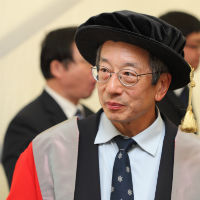 Roger Tsien came to the University of Cambridge on a Marshall Scholarship to in 1972 to work towards his Ph.D. with R.H. Adrian, son of E.D. Adrian. Tsien set out to design and synthesise new dyes for imaging neuronal activity and collaborated with Ian Baxter in the Chemistry Department. He eventually made the molecule we now call "BAPTA", from which fluorescent dyes were then developed for visualising calcium ions inside nerve cells and other cell types. After his PhD Tsien became a Research Fellow at Gonville & Caius College Cambridge and collaborated with Timothy Rink in the Physiological Laboratory, making calcium-selective electrodes and then fluorescent indicators for calcium. He moved to Berkley in 1982 and to UCSD in 1989.
Roger Tsien came to the University of Cambridge on a Marshall Scholarship to in 1972 to work towards his Ph.D. with R.H. Adrian, son of E.D. Adrian. Tsien set out to design and synthesise new dyes for imaging neuronal activity and collaborated with Ian Baxter in the Chemistry Department. He eventually made the molecule we now call "BAPTA", from which fluorescent dyes were then developed for visualising calcium ions inside nerve cells and other cell types. After his PhD Tsien became a Research Fellow at Gonville & Caius College Cambridge and collaborated with Timothy Rink in the Physiological Laboratory, making calcium-selective electrodes and then fluorescent indicators for calcium. He moved to Berkley in 1982 and to UCSD in 1989.
Roger Tsien was awarded the Nobel Prize in Chemistry 2008, along with Osamu Shimomura, Martin Chalfie, "for the discovery and development of the green fluorescent protein, GFP", work that he carried out at Berkley and UCSD.
http://www.nobelprize.org/nobel_prizes/chemistry/laureates/2008/tsien-bio.html
http://www.nobelprize.org/nobel_prizes/chemistry/laureates/2008/tsien-lecture.html
At the Tsien display, we will look at ways for visualising cells and calcium ions inside cells using tools that Roger Tsien developed.

